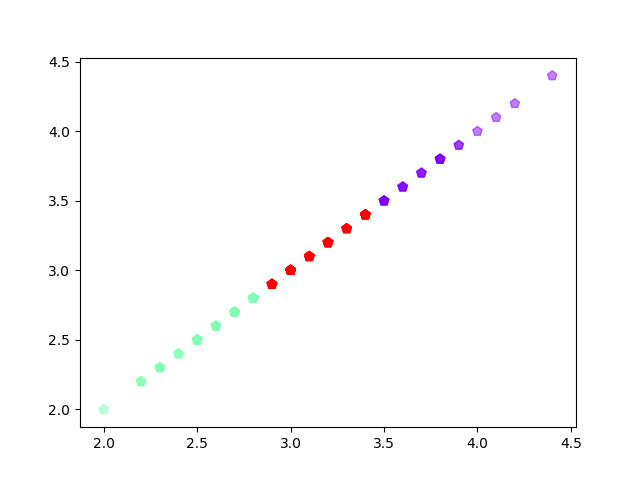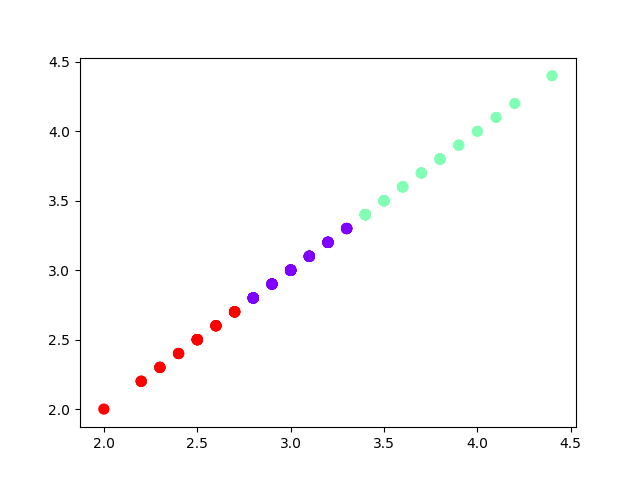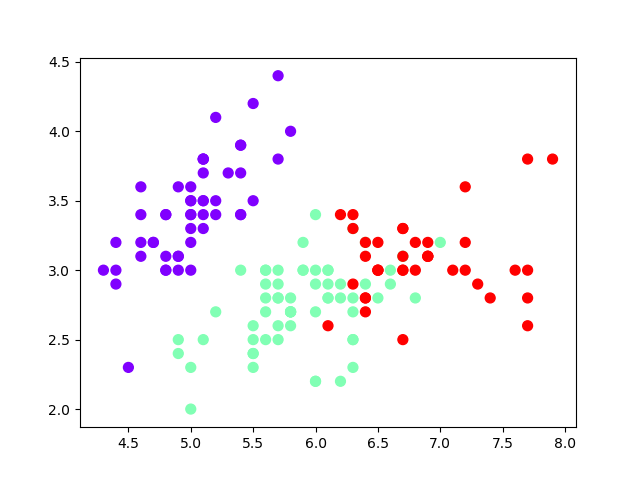2). *自主编写K-means算法 ,以鸢尾花花瓣长度数据做聚类,并用散点图显示。(加分题)
1 import numpy as np 2 from sklearn.datasets import load_iris 3 import matplotlib.pyplot as plt 4 5 iris = load_iris() 6 x = iris.data[:, 1] # 鸢尾花花瓣长度数据 7 y = np.zeros(150) 8 9 def initcent(x, k): # 初始聚类中心数组 10 return x[0:k].reshape(k) 11 12 def nearest(kc, i): # 数组中的值,与聚类中心最小距离所在类别的索引号 13 d = (abs(kc - i)) 14 w = np.where(d == np.min(d)) 15 return w[0][0] 16 17 def kcmean(x, y, kc, k): # 计算各聚类新均值 18 l = list(kc) 19 flag = False 20 for c in range(k): 21 m = np.where(y == c) 22 n = np.mean(x[m]) 23 if l[c] != n: 24 l[c] = n 25 flag = True # 聚类中心发生变化 26 return (np.array(l), flag) 27 28 def xclassify(x, y, kc): 29 for i in range(x.shape[0]): # 对数组的每个值分类 30 y[i] = nearest(kc, x[i]) 31 return y 32 33 k = 3 #3个聚类中心 34 kc = initcent(x, k) 35 flag = True 36 print(x, y, kc, flag) 37 while flag: 38 y = xclassify(x, y, kc) 39 kc, flag = kcmean(x, y, kc, k) 40 print(y, kc, type(kc)) 41 42 plt.scatter(x,x,c=y,s=50,cmap='rainbow',marker='p',alpha=0.5); 43 plt.show()
运行结果:

3). 用sklearn.cluster.KMeans,鸢尾花花瓣长度数据做聚类,并用散点图显示.
from sklearn.datasets import load_iris import matplotlib.pyplot as plt from sklearn.cluster import KMeans iris=load_iris() sl=iris.data[:,1] X=sl.reshape(-1,1) est=KMeans(n_clusters=3) est.fit(X) y_kmeans=est.predict(X) plt.scatter(X[:,0],X[:,0],c=y_kmeans,s=50,cmap='rainbow'); plt.show()
实验结果:

4). 鸢尾花完整数据做聚类并用散点图显示.
from sklearn.datasets import load_iris import matplotlib.pyplot as plt from sklearn.cluster import KMeans iris=load_iris() X=iris.data est=KMeans(n_clusters=3) est.fit(X) kc=est.cluster_centers_ y_kmeans=est.predict(X) print(y_kmeans,kc) print(kc.shape,y_kmeans.shape,X.shape) plt.scatter(X[:,0],X[:,1],c=y_kmeans,s=50,cmap='rainbow'); plt.show()
实验结果:

5).想想k均值算法中以用来做什么?
K-Means应用:
K均值算法在机器学习中属于简单易懂容易实现的算法之一,一般用于模式识别或者数据挖掘等等。